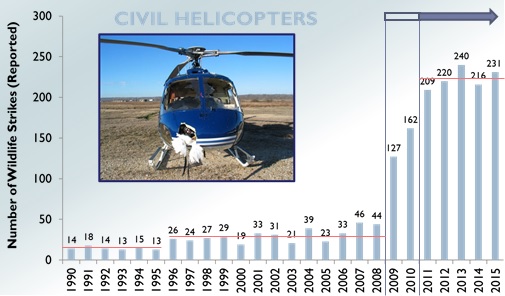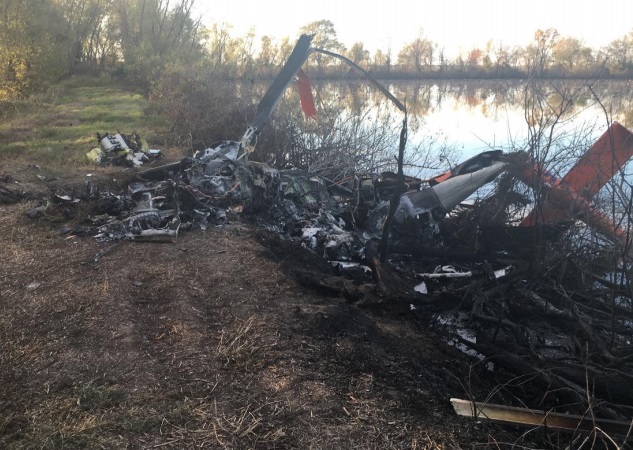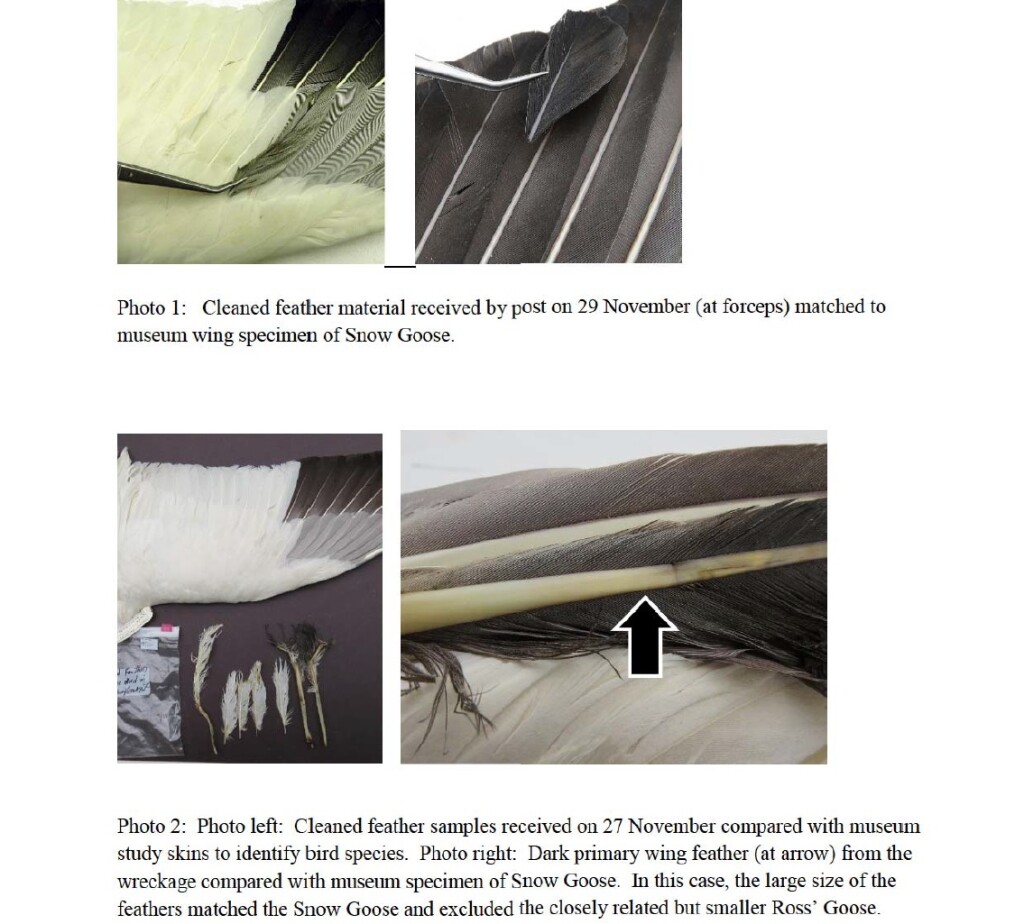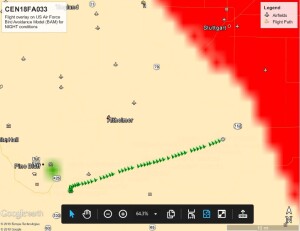Deadly Dusk Air Ambulance Bird Strike (Air Methods, B407, N620PA)
On 19 November 2017 Air Methods Corporation (AMC) air ambulance Bell 407 N620PA crashed south of Stuttgart, Arkansas. The helicopter was en route in Visual Meteorological Conditions (VMC) from Pine Bluff, Arkansas to pick up a patient in Helena, Arkansas. The pilot and two medical personnel on board were fatally injured.
The US National Transportation Safety Board (NTSB) explain in their safety investigation report that:
The helicopter was transmitting its position to the company via satellite communications. At 1855:50, the helicopter transmitted that it was heading 070°, travelling 116 knots at 1,252 ft mean sea level [so c 1,000 ft AGL]. This was the last recorded data point.
Air Methods informed the NTSB that:
Air Force SAR advised Company Operational Control Center of an ELT activation for the aircraft at 2015. The aircraft wreckage was located by local law enforcement some time prior to 2100, in a rural area approximately 22 nm ENE of the Pine Bluff Regional Airport (KPBF). The terrain in the crash area is…relatively flat, with mixed woodland and meadow terrain features.
The aircraft had just passed over the 33,832 acre Bayou Meto State Game Area to the west. Witnesses reported ‘thousands’ of geese in the local area.
NTSB Safety Investigation
A weather study conducted for the accident area did not reveal any weather hazards around the time of the accident. Both the sun and the moon were more than 15° below the horizon, and dark night conditions existed with no illumination from the moon.
The helicopter was found on the bank of a reservoir on its right side….
All major components of the helicopter were accounted for at the site. A post-impact fire consumed a majority of the fuselage.
Fragments of the pilot’s night vision goggles were located in the area of the pilot controls (company policy required pilots and one [medical] crewmember to wear night vision goggles during night flights.)
No pre-impact anomalies were detected during postaccident examination of the helicopter airframe or engine.
However:
During the on-scene portion of the investigation, numerous geese, ducks, and cranes were observed in the reservoir and at another nearby reservoir.
Multiple bird remains were found from the cockpit area to the first bulkhead. The Arkansas Crime Laboratory, Little Rock, Arkansas, conducted an autopsy on the pilot. The cause of death was multiple injuries. The autopsy noted white bird feathers embedded in the pilot’s coveralls and right boot.
Samples from the bird remains were sent to the Feather Identification Laboratory, Smithsonian Institution, National Museum of Natural History, Washington, DC.
In all the lab received 12 bags of debris. These were subjected to DNA and microscopic analysis.
Samples submitted to the Smithsonian contained remains from snow geese, which typically have an average weight of 4.8 and 5.48 lbs for females and males, respectively.
The NTSB note that:
The Bell 407 is certificated under 14 CFR Part 27 as a normal category rotorcraft. As such, there are no bird strike safety requirements for the windshield. Transport category rotorcraft do have a requirement under 14 CFR 29.631 to be designed to ensure capability of continued flight and/or landing, however the design requirement assumed a single 2.2 lbs bird. The accident involved numerous birds in excess of 4 lbs each.
A review of the FAA Wildlife Strike Database found a strike report for November 17, 2011, about 0705 [Local Time] the pilot of a Cessna 210 airplane reported striking a snow goose near the area of the accident site.
The US Air Force developed a Bird Avoidance Model (BAM) that analyzes and correlates bird habitats, migration patterns, and breeding characteristics with key environmental and man-made geospatial data. This model is used by military pilots and planners to monitor bird activity for strike mitigation purposes. Civilian pilots are not required to use the [free, online] model and the investigation was unable to determine if the accident pilot was aware of the available information.
At dusk, the strike probability for the accident area was forecast to be severe, and at night, the strike probability reduced to moderate.
In their analysis the NTSB comment:
While the helicopter flight controls were continuous, it could not be determined if the bird strikes jammed the pilot’s controls and/or incapacitated the pilot.
…there was no moon illumination to enhance the NVG effectiveness, and it is unlikely that the pilot would have been able to visually detect the birds before impact.
NTSB Probable Cause
An in-flight loss of control due to bird strikes.
Safety Resources
The European Space Agency (ESA) is managing the FlySafe project in Europe, initiated at the initiative of the Belgian and Dutch military, covering Germany, the Netherlands, Belgium and the southern edge of the North Sea. This gives bird activity predictions based on radar data.
In a presentation on behalf of the Rotorcraft Bird Strike Working Group (RBSWG) to the 11th EASA Rotorcraft Symposium in December 2017 it was revealed that in the US 94% of the current helicopter fleet is made up of types that never needed to meet a bird strike requirement. A helicopter accident (discussed below) and the Hudson A320 ditching, both in January 2009, were likely causes of a big increase in all wildlife strikes reporting across the US helicopter fleet. While fixed wing aircraft predominantly strike birds during take-off and landing, two thirds of rotorcraft strikes occurred during the en route phase (where kinetic energy is highest). Only 8-9% occurred during approach and 9-10% during climb. The presentation went on:
While fixed wing aircraft predominantly strike birds during take-off and landing, two thirds of rotorcraft strikes occurred during the en route phase (where kinetic energy is highest). Only 8-9% occurred during approach and 9-10% during climb. The presentation went on:
The largest single component struck by birds is the windshield with 47% on Part 27 and 40% on Part 29. 84-85% of all bird strikes occurred on components forward of the main rotor mast. This includes the main rotor which experienced 30%-33% of the strikes reported. Not one single record exists for windshield penetration on Part 29 rotorcraft certified to the FAA bird strike airworthiness standard established over 21 years ago. This is statistically significant. For newly manufactured and existing rotorcraft, the RBSWG proposed to use a Risk-Based Safety-Tiered approach that scales the bird strike regulation based on the maximum number of occupants onboard. As the number of occupants increases, so does the risk exposure.
They also recommend:
- Reduce airspeed when practical
- Increase altitude as quickly as possible and practical
- Use taxi and landing lights
They also say:
The location of bird concentrations during seasonal migrations and the local bird nesting and roosting habitats, should be made available to the rotorcraft operator/pilot for preflight planning to minimize the potential for bird strikes. Air carriers and general aviation operators working with the Flight Safety Programs and Flight Service Briefing should identify and publish the known locations and probability of bird concentrations. This information on bird concentrations should be incorporated into alert bulletins, flight service notice to airmen (NOTAM) and other systems presently used to inform flight crews of flight hazards.
The Flight Safety Foundation’s (FSF) Basic Aviation Risk Standard Offshore Helicopter Operations (BARSOHO), which has been fully aligned with the HeliOffshore Safety Performance Model (SPM) since February 2017, states in Controls 7.1 and 7.3:
Where known bird migratory routes or bird reserves are identified, flight crew must plan cruise altitudes greater than 3,000 feet Above Ground Level (AGL) wherever practical.
Aircraft routing must consider bird sanctuaries, known nesting areas and migratory bird paths as far as practical.
The BARSOHO Implementation Guidance states:
While the risk of in-flight collision with birds cannot be eliminated, it is recommended that strategies be considered by flight crew to minimize exposure to this threat when operating in areas of known migratory routes. Statistics reveal that the risk of birdstrike significantly reduces when aircraft are operated at higher altitudes.
An EASA Safety Information Bulletin (SIB) is expected shortly on helicopter bird strikes.
About 8% US military of all Class A, B and C aviation mishaps from fiscal 2011 through 2017 resulted from wildlife strikes, according to data obtained by Military Times.
We have previously written:
- Safety Lessons from a Fatal Helicopter Bird Strike: A fatal accident occurred on 4 Jan 2009 involving Sikorsky S-76C++ N748P of PHI that highlighted a range safety lessons. We also discuss current activity on enhancing bird strike requirements.
- USAF HH-60G Downed by Geese in Norfolk, 7 January 2014
- Swedish Military NOE Helicopter Bird Strike
- Power of Prediction: Foresight and Flocking Birds looks at how a double engine loss due to striking Canada Geese had been predicted 8 years before the US Airways Flight 1549 ditching in the Hudson (which was just days after the Louisiana helicopter accident).
- Final Report Issued on 2008 B737 Bird Strike Accident in Rome
- NTSB Recommendations on JT15D Failure to Meet Certification Bird Strike Requirements
- USAF T-38C Downed by Bird Strike
- Tragic Texan B206B3 CFIT in Dark Night VMC
- UPDATE 14 November 2020: HEMS EC135T1 CFIT During Mountain Take Off in Poor Visibility
- UPDATE 4 December 2020: Air Ambulance A109S Spatial Disorientation in Night IMC (N911NM)
- UPDATE 30 December 2020: AS350B3/H125 Bird Strike with Red Kite
- UPDATE 23 January 2021: US Air Ambulance Near Miss with Zip Wire and High ROD Impact at High Density Altitude
- UPDATE 31 January 2021: Fatal US Helicopter Air Ambulance Accident: One Engine was Failing but Serviceable Engine Shutdown
- UPDATE 17 July 2021: Sécurité Civile EC145 Mountain Rescue Main Rotor Blade Strike Leads to Tail Strike
- UPDATE 31 July 2021: Low Recce of HEMS Landing Site Skipped – Rotor Blade Strikes Cable Cutter at Small, Sloped Site
- UPDATE 21 August 2021: Air Methods AS350B3 Night CFIT in Snow
- UPDATE 19 September 2021: A HEMS Helicopter Had a Lucky Escape During a NVIS Approach to its Home Base
- UPDATE 15 January 2022: Air Ambulance Helicopter Struck Ground During Go-Around after NVIS Inadvertent IMC Entry
- UPDATE 23 March 2022: Big Bustard Busts Blade: Propeller Blade Failure After Bird Strike
- UPDATE 28 May 2022 AW169 Birdstrike with a Turkey Vulture
- UPDATE 17 February 2023: Dusk Duck: Birdstrike During Air Ambulance Flight
UPDATE 19 April 2021: EASA have issued Safety Information Bulletin SIB 2021-07 on Bird Strike Risk Mitigation in Rotorcraft Operations and accompanying safety promotion material.







Recent Comments